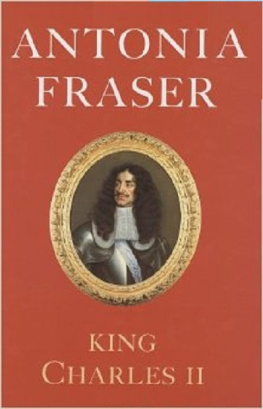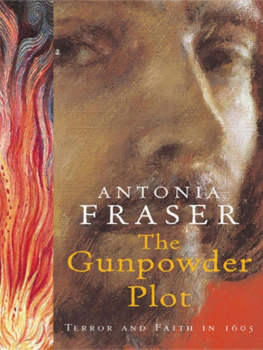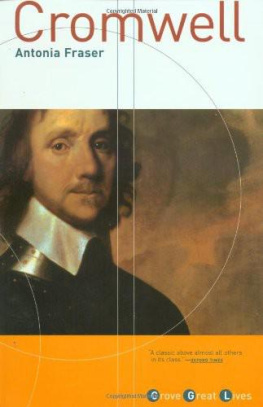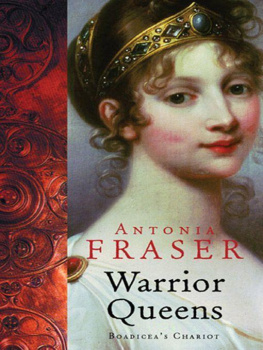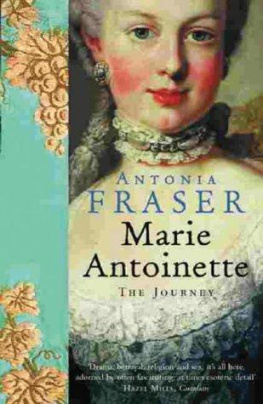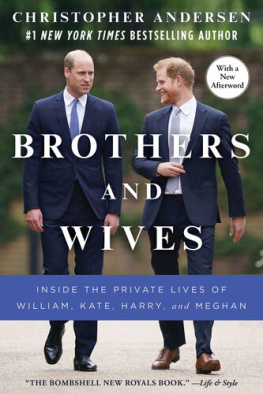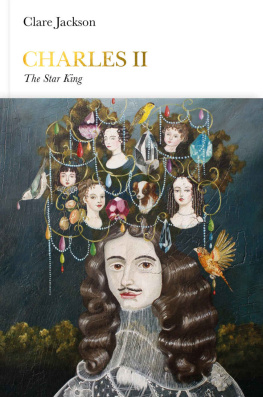King Charles II
ANTONIA FRASER
Contents
15 Black Day
For my mother and Harold
the first readers
with love
Antonia Fraser is the author of many widely acclaimed historical works including the biographies King Charles II, the recently republished Mary Queen of Scots and Marie Antoinette: The Journey which won the Franco-British Literary Prize in 2001 and was made into a film by Sofia Coppola in 2006. Most recently she has published Love and Louis XIV: The Women in the Life of the Sun King.
Antonia Fraser won a Wolfson History Prize in 1984, was made CBE in 1999, and was awarded the Norton Medlicott Medal by the Historical Association in 2000. She lives in London and has six children and eighteen grandchildren.
By Antonia Fraser
Mary Queen of Scots
Cromwell: Our Chief of Men
King James VI of Scotland, I of England
(Kings and Queens series)
King Charles II
The Weaker Vessel: Womans Lot
in Seventeenth-Century England
The Warrior Queens: Boadiceas Chariot
The Six Wives of Henry VIII
The Gunpowder Plot: Terror and Faith in 1605
Marie Antoinette: The Journey
Illustrations
Charles II and Jane Lane (Christies; photo A. C. Cooper)
Nell Gwynn (British Museum)
Effigy of Charles II (by courtesy of the Dean and Chapter of Westminster)
Authors Note
First and foremost this book has been a labour of love. I have always been fascinated by the character of King Charles II , sharing the view of Queen Victoria, who told Dean Stanley that, for all his moral failings, she regarded Charles II as one of the most attractive of her predecessors. I wanted to discover for myself whether he merited this long-held sympathy.
Romantic curiosity was the start. Curiosity of a different sort spurred me on when I was working on the life of Oliver Cromwell. What happened next to the young gentleman, as Cromwell himself sometimes described the exiled Charles II ? The Restoration of 1660 is such a convenient starting-point for historical studies: it is sometimes forgotten that Charles II was already thirty at the time of his return, with one whole dramatic existence behind him. I have hoped in my biography to span both periods of his life before and after 1660 and show their relation to each other.
Thirdly, as a historical work, this biography is in the nature of a re-assessment, based on the workings of many scholars in the field. There are surprisingly few biographies of any note of Charles II compared to some popular figures; paradoxically, we have been extremely fortunate in our historians of the period. Osmund Airys life (1901) should still be mentioned and Sir Arthur Bryants biography, concentrating on the reign itself (1931, revised 1955), is enduringly splendid. The most recent life, by Maurice Ashley (1972), is especially strong on the tortuous diplomacy of the period. Since that date there has been still more research made public and such valuable additions to our knowledge will undoubtedly continue to flow forth. In making my reassessment I gratefully acknowledge my debt to all scholars of the period, past and present. Finality is impossible fortunately, in my opinion, for who would wish the last word on King Charles II to have been spoken?
I have taken the usual liberties in correcting spelling and punctuation where it seemed necessary to make sense to the general reader today. For the same reason I have ignored the fact that the calendar year was held to start on 25 March during this period and have used the modern style of dates starting on 1 January throughout. There was a ten-day difference in dating between England and the Continent during this period England used Old Style (O.S.) and the Continent New Style (N.S.); once again, to avoid confusion, I have dated letters according to their source, occasionally giving both dates where necessary. Charles II was, of course, King of Great Britain, as we should term it today, but I have often used the term England to denote this area, as people did at the time.
I wish to thank Her Majesty the Queen for gracious permission to work in the Royal Archives at Windsor, Sir Robert Mack-worth-Young, the Royal Librarian, and Miss Langton of the Royal Library. I also wish to thank Dr Stephen R. Parks, Curator of the Osborn Collection, Yale University; the Director of the Pierpont Morgan Library, New York; Mr Richard W. Couper, President and Chief Executive, and Mr James W. Henderson, Director of Research Libraries, of the New York Public Library; Mr T. I. Rae, Keeper of the Department of Manuscripts, National Library of Scotland; and Dr A. L. Murray, Assistant Keeper of the Scottish Record Office, for allowing me to see the various manuscripts in their care.
I am most grateful to the following for assistance in different ways, representing the extraordinary variety displayed in the life of King Charles II : Lord Aberdare; Mr Howard Adams; Lt-Col. David Ascoli; Mr E. K. Barnard of the Cathedral Office, Portsmouth; Mr Neal Beck, Secretary of the King Charles Spaniel Club; Lord Clifford of Chudleigh; Lt-Col. A. Colin Cole, Garter King of Arms; Mr C. R. H. Cooper, Keeper of Manuscripts, and Mr M. V. Roberts of Enquiry Services, Guildhall Library; Mr Timothy Crist; Dr Chalmers Davidson; Mr Barry Denton of Northampton; Sir John Dewhurst, former President of the Royal College of Obstetricians and Gynaecologists; Mr J. F. Downes of Hook Norton; Mr Peter Foster, Surveyor of the Fabric of Westminster Abbey; Mr Eric J. Freeman, Librarian of the Wellcome Institute for the History of Medicine; Mr. J. R. Goulsbra, Secretary of the Royal Hospital, Chelsea; Mr John Gross; Mr Nigel Hamilton; Mr J. W. Hele, High Master of St Pauls School; Dr Albert E. J. Hollaender; Squadron-Leader L. R. Horrox; Mr Cyril Humphris; Mr Jonathan Israel; Mr Simon Jenkins; Mr R. C. Latham; Mr Raphael Loewe for translating the Sasportas letter; Mrs D. Maclaine, Secretary of the Cavalier King Charles Spaniel Club; Mr N. H. MacMichael, Keeper of the Muniments, Westminster Abbey; Mrs W. E. Macready, Honorary Secretary, Socit Jersiaise; Sir Iain Moncrieffe of that Ilk; Dr G. C. R. Morris; Mr Ferdinand Mount; Mrs P. M. OConnor, Honorary Secretary, Marlipins Museum, Shoreham; Miss Jane OHara-May; Mr Richard Ollard; Mrs Julia Parker for her horoscope of King Charles II ; Mr George Pinker; Mr Anthony Powell; Lady Violet Powell; Mr John Sales, Curator of the Bridport Museum; Mr Edgar Samuel; Mr A. Schishca; Mr Arthur M. Schlesinger, Jr; Dr Jan Den Tex; Miss Audrey Williamson; Professor I. Tishby of Jerusalem for permission to quote from the unpublished letter of Rabbi Jacob Sasportas; and Mr Steen Vedel for the unpublished diary of his ancestor Corfitz Bram.
Professor J. P. Kenyon read the manuscript at an early stage and made many helpful criticisms. Peter Earle and Gila Falkus also read the manuscript and made suggestions. Dr Maurice Ashley kindly read the proofs. I was delighted to get to know Sir Arthur Bryant through our shared interest in King Charles II , and to receive his encouragement. Anne Somerset gave me vital assistance in checking references and making good any omissions; my daughter, Flora Fraser, carried on the good work. Above all, Christopher Falkus of Weidenfelds was a tower of strength at every stage.

